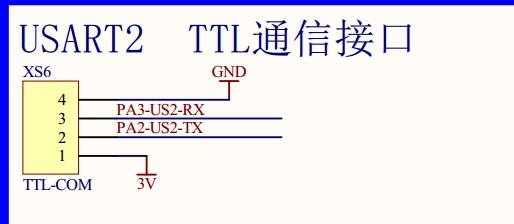原理图:


头文件及完整例程下载:http://www.51hei.com/f/stm32标准例程库函数.rar
程序分析:
int main(void)
{
uint8_t a=0;
/* System Clocks Configuration */
RCC_Configuration(); //系统时钟设置
/*嵌套向量中断控制器
说明了USARTx抢占优先级级别0(最多1位) ,和子优先级级别0(最多7位) */
NVIC_Configuration(); //中断源配置
/*对控制LED指示灯的IO口进行了初始化,将端口配置为推挽上拉输出,口线速度为50Mhz。PA2,PA2端口复用为串口2的TX,RX。
在配置某个口线时,首先应对它所在的端口的时钟进行使能。否则无法配置成功,由于用到了端口B, 因此要对这个端口的时钟
进行使能,同时由于用到复用IO口功能用于配置串口。因此还要使能AFIO(复用功能IO)时钟。*/
GPIO_Configuration(); //端口初始化
USART_Config(USART2); //串口1初始化
USART_OUT(USART2,"****(C) COPYRIGHT 2013 奋斗嵌入式开发工作室 *******\r\n"); //向串口1发送开机字符。
USART_OUT(USART2,"* *\r\n");
USART_OUT(USART2,"* 奋斗版STM32开发板 USART2 实验 *\r\n");
USART_OUT(USART2,"* *\r\n");
USART_OUT(USART2,"* 以HEX模式输入一串数据,以16进制0d 0a作为结束 *\r\n");
USART_OUT(USART2,"* *\r\n");
USART_OUT(USART2,"* 奋斗STM32论坛:www.ourstm.net *\r\n");
USART_OUT(USART2,"* *\r\n");
USART_OUT(USART2,"***************************************************\r\n");
USART_OUT(USART2,"\r\n");
USART_OUT(USART2,"\r\n");
while (1)
{
if(rec_f==1){ //判断是否收到一帧有效数据
rec_f=0;
USART_OUT(USART2,"\r\n您发送的信息为: \r\n");
USART_OUT(USART2,&TxBuffer1[0]);
if(a==0) {GPIO_SetBits(GPIOB, GPIO_Pin_5); a=1;} //LED1 V6(V3板) V2(MINI板) 明暗闪烁
else {GPIO_ResetBits(GPIOB, GPIO_Pin_5);a=0; }
}
}
}
时钟初始化RCC_APB2Periph_GPIOA ()
void RCC_Configuration(void)
{
SystemInit();
RCC_APB2PeriphClockCmd( RCC_APB2Periph_GPIOA | RCC_APB2Periph_GPIOB |RCC_APB2Periph_GPIOD |
RCC_APB2Periph_AFIO , ENABLE);
RCC_APB1PeriphClockCmd( RCC_APB1Periph_USART2, ENABLE);
}
中断向量初始化,分组NVIC_PriorityGroup_0 ,初始化USART2_IRQn
void NVIC_Configuration(void)
{
/* 结构声明*/
NVIC_InitTypeDef NVIC_InitStructure;
/* Configure the NVIC Preemption Priority Bits */
/* Configure one bit for preemption priority */
/* 优先级组 说明了抢占优先级所用的位数,和子优先级所用的位数 在这里是1, 7 */
NVIC_PriorityGroupConfig(NVIC_PriorityGroup_0);
NVIC_InitStructure.NVIC_IRQChannel = USART2_IRQn; //设置串口2中断
NVIC_InitStructure.NVIC_IRQChannelPreemptionPriority = 0; //抢占优先级 0
NVIC_InitStructure.NVIC_IRQChannelSubPriority = 0; //子优先级为0
NVIC_InitStructure.NVIC_IRQChannelCmd = ENABLE; //使能
NVIC_Init(&NVIC_InitStructure);
}
GPIO初始化
void GPIO_Configuration(void)
{
GPIO_InitStructure.GPIO_Pin = GPIO_Pin_5; //LED1控制--PB5
GPIO_InitStructure.GPIO_Mode = GPIO_Mode_Out_PP; //推挽输出
GPIO_InitStructure.GPIO_Speed = GPIO_Speed_50MHz;
GPIO_Init(GPIOB, &GPIO_InitStructure);
GPIO_InitStructure.GPIO_Pin = GPIO_Pin_12; //RS485输入输出控制
GPIO_InitStructure.GPIO_Mode = GPIO_Mode_Out_PP; //推挽输出
GPIO_InitStructure.GPIO_Speed = GPIO_Speed_50MHz;
GPIO_Init(GPIOD, &GPIO_InitStructure);
GPIO_SetBits(GPIOD, GPIO_Pin_12); //RS485输出模式 禁止485输入
GPIO_InitStructure.GPIO_Pin = GPIO_Pin_2; //USART2 TX
GPIO_InitStructure.GPIO_Mode = GPIO_Mode_AF_PP; //复用推挽输出
GPIO_Init(GPIOA, &GPIO_InitStructure); //A端口
GPIO_InitStructure.GPIO_Pin = GPIO_Pin_3; //USART2 RX
GPIO_InitStructure.GPIO_Mode = GPIO_Mode_IN_FLOATING; //复用开漏输入
GPIO_Init(GPIOA, &GPIO_InitStructure); //A端口
GPIO_InitStructure.GPIO_Pin = GPIO_Pin_13; //LCD背光控制
GPIO_InitStructure.GPIO_Speed = GPIO_Speed_50MHz;
GPIO_InitStructure.GPIO_Mode = GPIO_Mode_Out_PP;
GPIO_Init(GPIOD, &GPIO_InitStructure);
GPIO_ResetBits(GPIOD, GPIO_Pin_13); //LCD背光关闭
}
void USART_Config(USART_TypeDef* USARTx){
USART_InitStructure.USART_BaudRate = 115200; //速率115200bps
USART_InitStructure.USART_WordLength = USART_WordLength_8b; //数据位8位
USART_InitStructure.USART_StopBits = USART_StopBits_1; //停止位1位
USART_InitStructure.USART_Parity = USART_Parity_No; //无校验位
USART_InitStructure.USART_HardwareFlowControl = USART_HardwareFlowControl_None; //无硬件流控
USART_InitStructure.USART_Mode = USART_Mode_Rx | USART_Mode_Tx; //收发模式
/* Configure USARTx */
USART_Init(USARTx, &USART_InitStructure); //配置串口参数函数
/* Enable USARTx Receive and Transmit interrupts */
USART_ITConfig(USART2, USART_IT_RXNE, ENABLE); //使能接收中断
USART_ITConfig(USART2, USART_IT_TXE, ENABLE); //使能发送缓冲空中断
/* Enable the USARTx */
USART_Cmd(USART2, ENABLE);
}
|